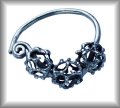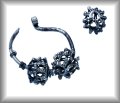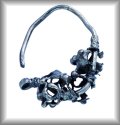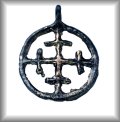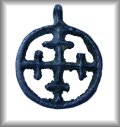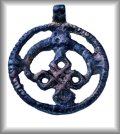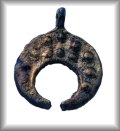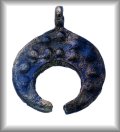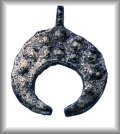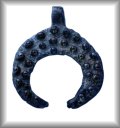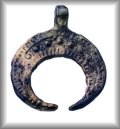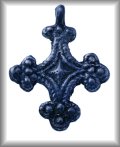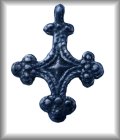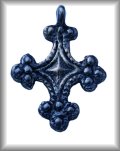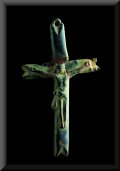



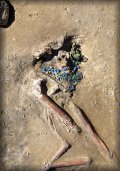
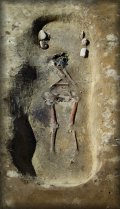

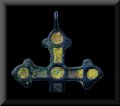
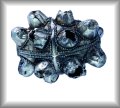
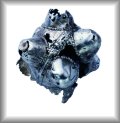
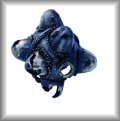
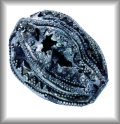
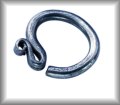
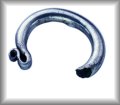
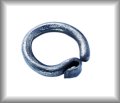
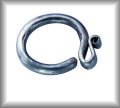

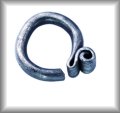
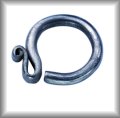
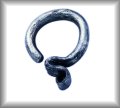
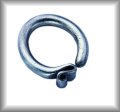
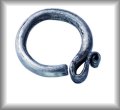
Dariusz Krasnodębski
Work on the gas pipeline construction project near the village of Daniłowo Małe, on the south-west edge of the valley of the River Narew led to the discovery of a richly furnished cemetery dating from the eleventh century ad. The burial ground in question lies on a steep bank leading down to an area of marshy meadows making up the floodplain of the River Liza (a tributary of the Narew), situated approximately 1 km away. Historical and archaeological sources indicate that during the eleventh century these marshlands, covering over 30 km in length, marked the border between Russia and Mazovia. At this time, the fortified settlement of Suraż, which lies approximately 4 km to the east of Daniłowo, constituted the most north-easterly outpost of the Kiev state.
Mention is made of Daniłowo itself in written sources dating from the early thirteenth century, which record that it belonged to Bishopric of Płock.
The area in which the cemetery was discovered is known as "grey stones" among the local villagers and numerous legends are associated with it.
To-date, nearly fifty graves of men, women and children have been found at this site. The majority of these were inhumations, with only a small proportion of cremation burials. The graves were arranged in rows, forming small clusters of two to five burials (possibly a family group). Large boulders were either placed around the burial pit, creating a stone enclosure, or else smaller stones were packed tightly over the entire surface of the grave. Several graves contained double burials. The bodies were positioned on an east-west axis, males being buried with their heads pointing east, whilst female burials pointed west. Excavations have shown that, in at least some of the graves, planks were placed around the burial, forming a coffin of sorts. Although this construction had neither a bottom nor a lid, it was often further reinforced at the sides with field stones.
Anthropological analysis of the skeletal material recovered from the cemetery reveals that, on average, those buried here seldom lived for more than thirty-five years.
The depth of graves ranged from c. 20 to over 50 cm.
Most of the graves contained burial assemblages. The most commonly found items in female graves included variously coloured glass beads, S-shaped head-band ornaments made of silver or bronze, silver beads and ear-rings, bronze and silver finger-rings, as well as tin-coated copper pendants in the shape of crosses, crescent-moons (lunulae) or round, open-work discs with a cross and lunula motif. Single finds of a bronze bracelet and bell-shaped pendant were also recorded.
Male graves were more modestly furnished. They contained spearheads, spurs, pins, fragmentary remains of stave buckets (the iron fittings of which survive) and belt buckles.
Iron knives were frequently found accompanying both male and female burials. In some instances copper scabbard fittings were also noted. Other grave goods included iron fire-lighters, often complete with flints.
Alongside items of everyday use, weapons and ornaments, food offerings also seem to have been deposited with the dead to provision them for the afterlife, as suggested by the presence of buckets and fragments of animal bone. These were often placed in pits situated next to the burial chamber.
Of particular interest was a male burial which was found to contain a 28 cm-long spearhead (with a textile impression) and a series of other iron objects: a pin and a belt buckle with inlaid silver decoration. These artefacts were clearly part of a set which had been produced by one craftsman.
The graves of two young females were also noteworthy. The first of these contained over twenty headband ornaments, four spiral wire finger-rings made of bronze, a necklace consisting of nearly two hundred glass beads and a set of seventeen bronze pendants comprising cruciform varieties, lunulae and a circular openwork disc with a combined motif depicting a cross with limbs of equal length and a lunula. These types of ornament occur predominantly in Russia, in those territories inhabited during the early medieval period by Dregowicz communities (modern-day Byelorussia).
Fifty-five nodular beads and over a dozen small headband ornaments were recovered from the second most richly furnished female grave. The egg-shaped beads were made of thin, sheet silver which had been beaten into shape. Nodules were subsequently soldered on to the beads to add to their filigree and granular decoration. The discovery at the Daniłowo cemetery site marked the first occasion on which nodular beads had been found in a grave. This burial also contained a double stranded bronze wire bracelet with curled ends - a find typically encountered in barrow graves from the territories of Byelorussia - and a solitary bell and hood-shaped pendant, mostly known from sites in Lithuania and Latvia.
An interesting collection of thirteen basket-shaped ear-rings came from four further burials. These items were made of thin, interlaced silver wires. Three openwork beads, embellished using a combination of filigree and granulation techniques, were found attached to a headband ornament measuring approximately 2.5 cm across. Headbands decorated in this fashion were often worn by Dregowicz women.
The materials recovered from the Daniłowo cemetery and the burial types found there indicate that this site is representative of Mazovian mortuary practices (in which burial pits are surrounded by stone enclosures or covered with cobble paving), whilst the grave goods are characteristic of the material cultures of Mazovian, Russian and the Balt societies. Nevertheless, the predominance of western Slavic artefacts (such as S-shaped headband ornaments and nodular beads), in combination with the aforementioned stone enclosure, burials point to the overall Mazovian character of the cemetery.
BACK
